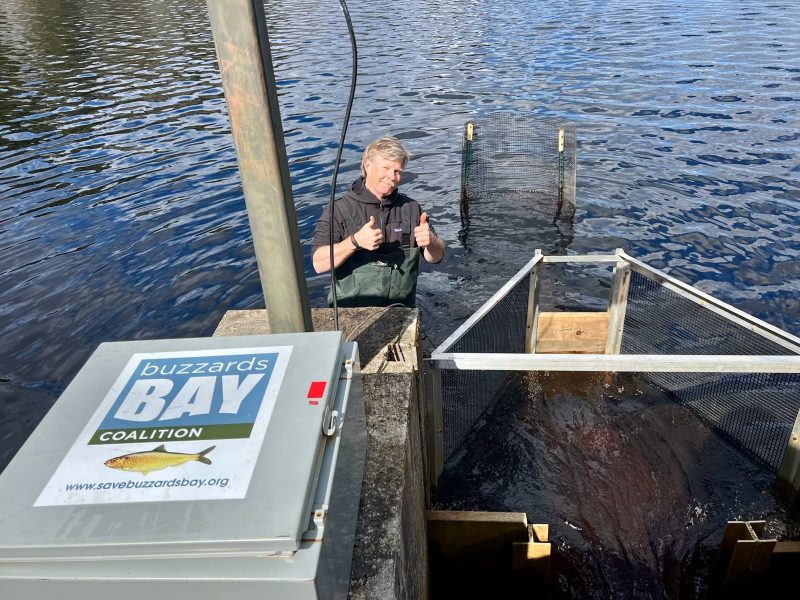WHAT WE DO: Installing a River Herring Counting Monitor in Rochester
This is part of a series of profiles of Coalition staff and partners that highlight the work our seasoned and expert professionals do.
On a chilly late March day, Tony Williams stands in waist-high water by the dam at a fish ladder in Rochester. He gestures to colleague Patrick Igoe for another piece of equipment that is needed for installation of an electronic Smith-Root fish counting apparatus. The roar of water rushing into the dam makes communication difficult. But the reassembly of the fish-counting monitor here at the fish ladder, which hundreds of river herring use to travel upriver to spawn, is going swimmingly.
Williams and Igoe have driven down dirt roads off the beaten path through still-dormant cranberry bogs and unloaded their gear to be carried the rest of the way to the river. They began by fitting the large metal screen used to funnel the fish to a central counting spot on the dam side of the fish ladder. After that is secured, they slide some wooden boards down into the funnel screen underwater that will set the height of a counting tube extension through which the fish will swim. Then they add another board to keep it secure.

Director of Monitoring Programs Tony Williams gives the thumbs up after he installs a fish monitor at a local fish ladder.
They set up the solar power panel that will supply power to the electronic Smith-Root counting monitor. They run a solar power cord along the railing into a steel box that is secured and locked onto the same railing to protect the counting monitoring instruments. Within that box is placed a regular car battery and the breadbox-sized counting monitor, which tallies the fish that swim through the sensor-equipped tube. The monitor comes to life when all are plugged in together and the system is online.
Williams must test the contraption. He has affixed a water bottle (as a pretend fish) to a thin nylon rope and lets it cascade into the tube. Once it has reached the other side, he pulls it back through the tube at the speed a herring would swim against the strong current through the tube. Bingo! The monitor registers movement through the tube and makes a tally of it.
The final step: He sets up another screen a few feet upstream of the counting tube to divert any large debris floating downstream from clogging the opening of the tube so that the fish always have free passage to swim upstream through the counting tube.
This fish counting monitoring gear is one of five set up by the Buzzards Bay Coalition’s science staff at various strategic points in the Bay’s watershed rivers. All will be in the water by the beginning of April to collect data on the numbers of river herring at each checkpoint. The Buzzards Bay Coalition will then provide this data to the Massachusetts Division of Marine Fisheries (DMF) after the spawning season is completed in June. After Williams installs each counting monitor, a number of his river herring counting volunteers will check them on a frequent basis to ensure they are working correctly and record the counts until the gear is removed from the rivers at the beginning of June.
Are you interested in visiting a herring run? Click here for ones in our area. If you do stumble upon one of our monitors, please observe the fish but let the monitor do its work.